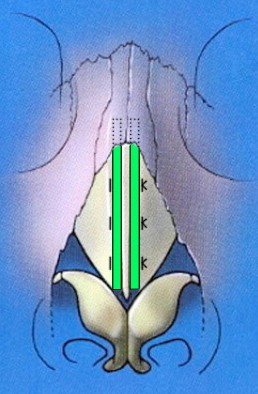Spreader Grafts
In 1982 Jack Sheen presented his paper describing spreader grafts in Las Vegas and so began a change in rhinoplasty from a focus on reductive techniques (removing tissue) to augmenting and preserving techniques. Spreader grafts are a very useful technique in addressing problems in the middle third of the nose and have a number of indications.
What are spreader grafts?
Spreader grafts are small strips of cartilage (like sticks) or bone which are inserted next to the nasal septum on the dorsum (top) of the nose. They are generally used as a pair, one on either side of the nasal septum but can also be inserted on one side. There can also be multiple spreader grafts placed on one side if there is asymmetry that needs to be corrected. In more recent times the autospreader flap has become a popular alternative with a similar function.
One distinct advantage of a spreader graft compared to an onlay graft is that it opens the nasal valve by pushing the lateral nasal sidewall out slightly. This improves breathing as well as the appearance of the nose.
When are spreader grafts useful?
- After hump removal
In primary rhinoplasty when a hump is removed spreader grafts are used to add strength and support the middle third of the nose. A “hump” is actually the top part of the nasal septum, upper lateral cartilages and their junction with the nasal bones. When you remove those delicate connections there is a tendency for all of the above structures to fall inwards with time. Spreader grafts are inserted to prevent this occurring. Patients with short nasal bones, thin skin and long cartilages at most at risk. - To correct an asymmetry in the middle third of the nose
An bend in the middle third of the nose can be addressed through an onlay graft or through spreader grafts. A spreader graft has the advantages of also improving the airway and preserving the anatomical line from nasal bone to upper lateral cartilage. - To rebuild a collapsed middle third
After trauma or previous surgery the middle third of the nose may collapse if it has not been adequately supported. Spreader grafts are useful to rebuild the dorsum (top) of the nose and join it to the nasal bones and nasal tip. - To improve the airway at the nasal valve
The internal nasal valve is the narrowest part of the nasal airway. Small changes here can make a significant difference in breathing. Spreader grafts are one technique of a number that are used to improve airflow through the nasal valve area.
How are spreader grafts inserted?
Generally spreader grafts are inserted through an open approach rhinoplasty. They can be placed through a closed approach rhinoplasty in some situations.


